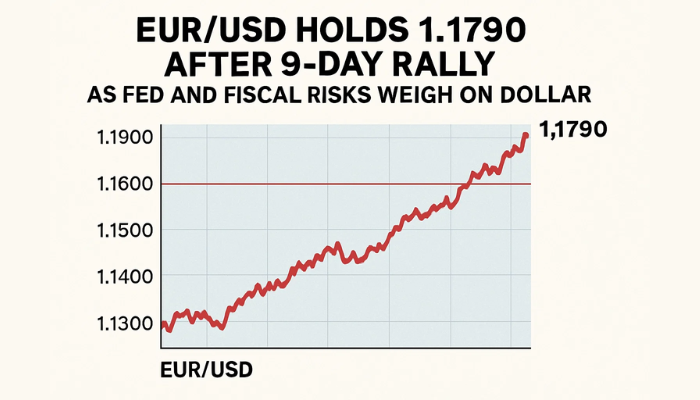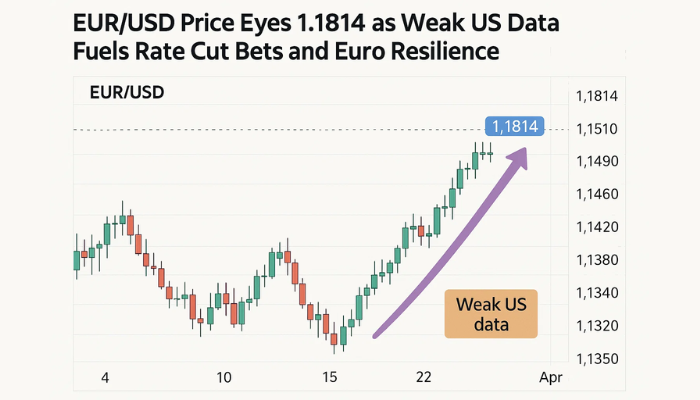Prices Forecast: Technical Analysis
For the EUR/USD, the predicted daily closing price is approximately 1.1785, with a range between 1.1750 and 1.1820. The weekly closing price is forecasted to be around 1.1800, with a range from 1.1720 to 1.1880. The RSI is currently at 70.7697, indicating a bullish trend as it approaches overbought territory. The ATR at 0.0088 suggests moderate volatility, while the ADX at 28.1874 shows a strong trend. The MACD line is above the signal line, reinforcing the bullish sentiment. The Bollinger Bands indicate a potential for price expansion, with the current price nearing the upper band. These technical indicators suggest a continuation of the upward momentum, but traders should be cautious of potential pullbacks due to the overbought RSI.
Fundamental Overview and Analysis
Recently, EUR/USD has shown a strong upward trend, driven by positive economic data from the Eurozone and a weaker USD. The Italian Retail Sales data, although slightly below expectations, still supports a positive economic outlook for the Eurozone. Market participants are optimistic about the Euro’s performance, viewing it as a stable currency amidst global uncertainties. Opportunities for growth include the Eurozone’s economic recovery and potential ECB policy adjustments. However, risks such as geopolitical tensions and potential ECB rate hikes could pose challenges. Currently, the EUR/USD appears fairly valued, with room for growth if economic conditions remain favorable. Investors should monitor economic indicators and central bank policies closely.
Outlook for EUR/USD
The future outlook for EUR/USD remains positive, with expectations of continued upward momentum. Historical price movements show a strong bullish trend, supported by favorable economic conditions in the Eurozone. Key factors influencing the price include ECB policy decisions, economic data releases, and USD strength. In the short term (1 to 6 months), EUR/USD is expected to trade between 1.1700 and 1.1900, with potential for further gains if economic conditions improve. Long-term forecasts (1 to 5 years) suggest a gradual appreciation of the Euro, driven by economic recovery and potential policy shifts. External factors such as geopolitical events and global economic trends could significantly impact the asset’s price.
Technical Analysis
Current Price Overview: The current price of EUR/USD is 1.1783, slightly below the previous close of 1.1800. Over the last 24 hours, the price has shown a slight downward correction, with moderate volatility and no significant candlestick patterns.
Support and Resistance Levels: Key support levels are at 1.1750, 1.1720, and 1.1700, while resistance levels are at 1.1820, 1.1850, and 1.1880. The pivot point is at 1.1800, with the asset trading slightly below it, indicating potential for a bullish reversal.
Technical Indicators Analysis: The RSI at 70.7697 suggests a bullish trend, nearing overbought levels. The ATR of 0.0088 indicates moderate volatility. The ADX at 28.1874 shows a strong trend. The 50-day SMA is above the 200-day EMA, indicating a bullish crossover.
Market Sentiment & Outlook: Sentiment is currently bullish, supported by price action near the pivot, a strong RSI, and a bullish moving average crossover. Moderate volatility suggests potential for further gains.
Forecasting Returns: $1,000 Across Market Conditions
Investing $1,000 in EUR/USD can yield different outcomes based on market conditions. In a Bullish Breakout scenario, a 5% increase could raise the investment to ~$1,050. In a Sideways Range, the investment might remain around ~$1,000. In a Bearish Dip, a 3% decrease could lower it to ~$970. These scenarios highlight the importance of market conditions on investment returns. Investors should consider current trends and technical indicators before making decisions. Diversifying investments and setting stop-loss orders can help manage risks.
| Scenario | Price Change | Value After 1 Month |
|---|---|---|
| Bullish Breakout | +5% to ~$1,237 | ~$1,050 |
| Sideways Range | 0% to ~$1,180 | ~$1,000 |
| Bearish Dip | -3% to ~$1,143 | ~$970 |
FAQs
What are the predicted price forecasts for the asset?
The daily closing price for EUR/USD is predicted to be around 1.1785, with a range between 1.1750 and 1.1820. The weekly closing price is forecasted at approximately 1.1800, with a range from 1.1720 to 1.1880. These predictions are based on current technical indicators and market trends.
What are the key support and resistance levels for the asset?
Key support levels for EUR/USD are identified at 1.1750, 1.1720, and 1.1700. Resistance levels are at 1.1820, 1.1850, and 1.1880. The pivot point is at 1.1800, with the asset currently trading slightly below it, suggesting potential for a bullish reversal.
Disclaimer
In conclusion, while the analysis provides a structured outlook on the asset’s potential price movements, it is essential to remember that financial markets are inherently unpredictable. Conducting thorough research and staying informed about market trends and economic indicators is crucial for making informed investment decisions.



